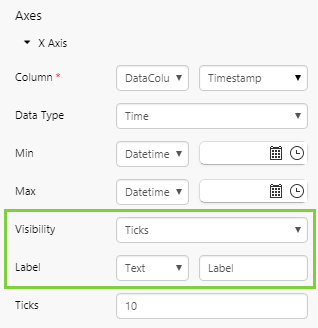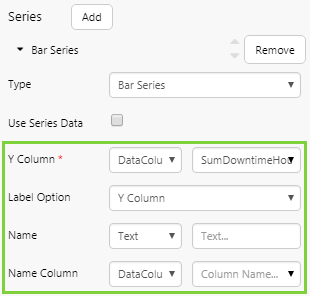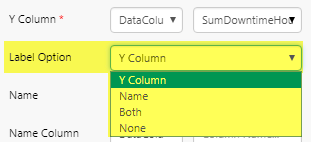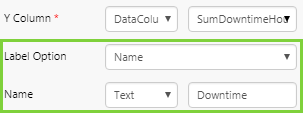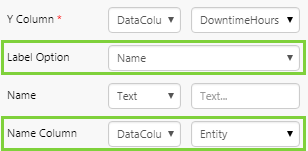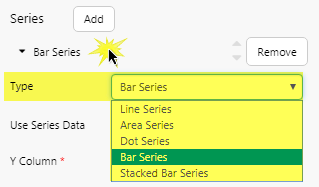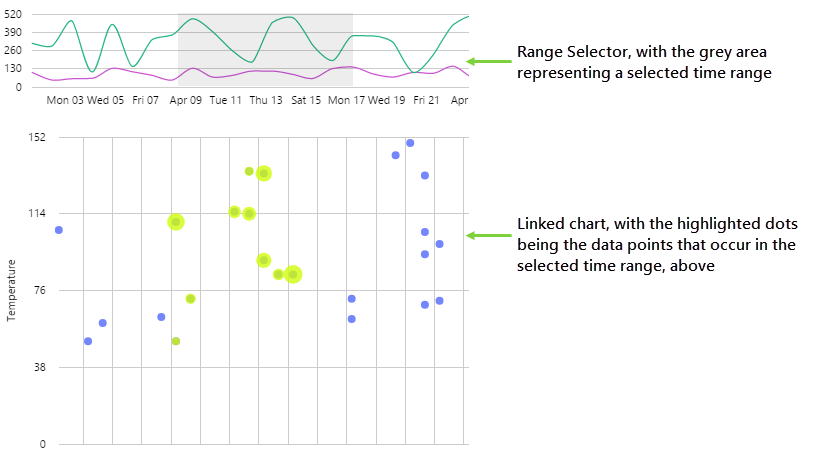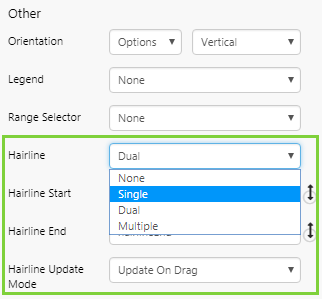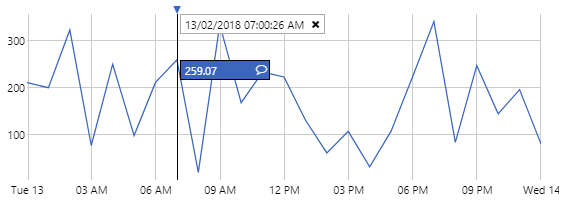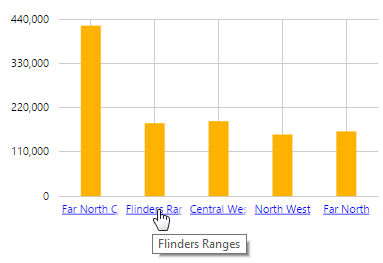ON THIS PAGE:
How do I update a variable from a chart?
You can configure a discrete chart (X Axis data type is String) so that when a user clicks on an area of the chart, this updates a variable on the page with the selected X Axis value. The variable can then used by other page components, such as a data label, a parameter to a dataset query, or a variable for a hyperlink.
1. Add a text variable to the page defaults, and give it a value.
2. Click the chart to configure it, and expand the X Axis on the chart's properties. From the Selected drop-down list, choose the new variable name.
Note: Ensure that the chart is a discrete chart, i.e. the X Axis Data Type must be String.
How do I add a label?
You can add a label to the X Axis, Left Y Axis, and Right Y Axis. The configuration is the same for each section.
There are two applicable settings: Visibility and Label.
Visibility: Ensure this is set to either Ticks or Both.
Label: Either keep Text and type a label in the edit box, or select Variable and then choose a variable from the drop-down list.
How do I add a legend?
Chart legends have a key that matches to the series by colour and series type (e.g. a blue bar matching the blue bar series). You need to assign a name to each of the chart's series, and then enable the legend.
1. For each series in the chart, expand the the series (e.g. Bar Series). There are 4 settings that control the name displayed in the legend: Y Column, Label Option, Name, and Name Column.
From the Label Option drop-down list, choose where you want your label to come from. The default (Y Column) simply displays the name you have selected from the Y Column drop-down list.
Depending on which option you choose, you will need to configure different settings, as shown in the following tables. There will be a difference in the way the options are handled between a standard series and a split series.
Standard Series:
Split Series: For split series, selecting the Y Column option will result in each item in the legend having the same name, which is generally not the desired behaviour. For a meaningful legend, you should configure Label Option as either Name or Both:
2. In the Other properties, click the Legend drop-down list to select a legend position.
How do I change a series type?
To change a series type (e.g. bar series to line series):
1. Click a series to expand it.
2. From the Type drop-down list, select a different series type.
What is a Range Selector and how do I configure it?
Range selectors allow the user to select a time or number range, and are only available for continuous charts (X Axis data type is Time or Number). Range selectors are useful when linking charts and provide a more rich, interactive experience with data.
The configuration options for a range selector are found in the 'Other' properties of the range selector chart. The range selector then uses the Highlight properties of the linked chart.
For a practical example of how to configure a range selector with a linked chart, see Chart tutorial 2 - Part 1.
How do I enable a Hairline?
A hairline shows the value of a data point at the X Axis position that a user clicks, and is only available for continuous charts (X Axis data type is Time or Number). Charts can be configured to add one, two, or more hairlines.
Tip: If the name of the series does not appear in the hairline, check that the Label Option for the series is not set to None. Here are some ways they can be configured:
How do I enable Comments?
Comments are observations made at a point in time that users can associate with a particular tag, entity, or entity attribute. Comments are only available for continuous charts (X Axis data type is Time or Number).
When comments are enabled on a chart, a ![]() symbol in the hairline indicates that users can click it to add a comment.
symbol in the hairline indicates that users can click it to add a comment.
If a comment has been added, this is shown by a coloured comment marker ![]() on the chart itself, at the point in time when the comment was added. The colour of the marker corresponds to the series colour of the data item against which the comment is made. You can click the symbol to see the comments and add additional ones.
on the chart itself, at the point in time when the comment was added. The colour of the marker corresponds to the series colour of the data item against which the comment is made. You can click the symbol to see the comments and add additional ones.
How do I add links on the X Axis?
A chart that has an X axis of type String can be configured for a Link Action. When a user clicks the link, then depending on the configuration this either sets variables on the page, or a new page, trend, or URL is opened.
Links for opening a page, trend or URL can be further configured to pass variables to the page/trend/URL; these can be values from the page, and can include contextual data, such as the selected X Axis value.
For a practical example of how to create links on the X Axis, see Charts Tutorial 1 - Part 2.
How do I make a Sparkline?
In Explorer, you can add a sparkline as part of a process mimic or schematic, or you can add it to a Table Layout to trend related data in a table.
You need to first configure a line chart to use data, and then configure its appearance to look like a sparkline, by removing gridlines and labels.
Release History
- FAQ - Configuring Charts 4.6.2 (this release)
- Charts can be configured so that page variables are set when the X-Axis is clicked.
- FAQ - Configuring Charts 4.5.5
- Updated editor options
- Updated comment marker format
- Updated hairline format
- FAQ - Configuring Charts 4.5.0
- FAQ - Configuring Charts 4.4.6


